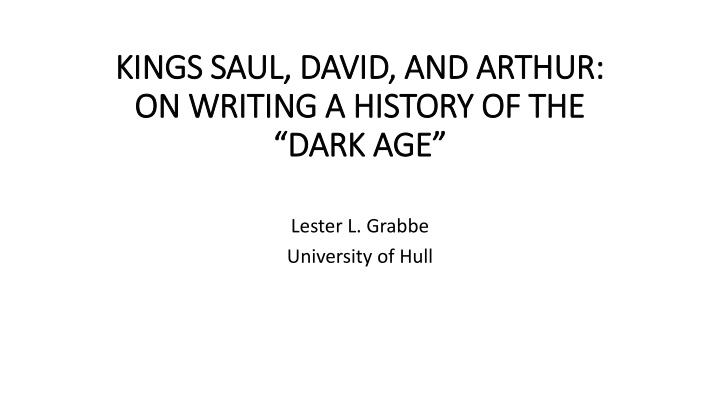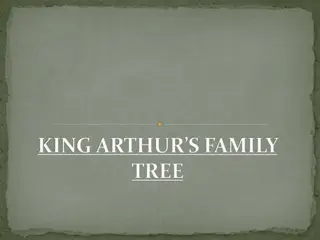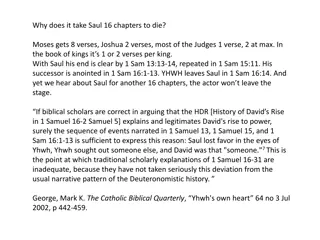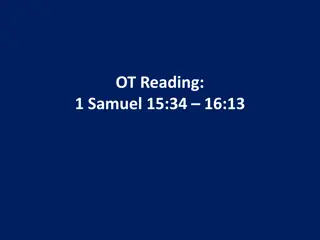Kings Saul, David, and Arthur in Dark Age History
Dive into the historical periods of King Arthur in the 6th century, King Saul and King David in the 10th century BCE, debunking myths and examining literary sources such as Gildas' "De Excidio Britanniae".
Download Presentation

Please find below an Image/Link to download the presentation.
The content on the website is provided AS IS for your information and personal use only. It may not be sold, licensed, or shared on other websites without obtaining consent from the author.If you encounter any issues during the download, it is possible that the publisher has removed the file from their server.
You are allowed to download the files provided on this website for personal or commercial use, subject to the condition that they are used lawfully. All files are the property of their respective owners.
The content on the website is provided AS IS for your information and personal use only. It may not be sold, licensed, or shared on other websites without obtaining consent from the author.
E N D
Presentation Transcript
KINGS SAUL, DAVID, AND ARTHUR: KINGS SAUL, DAVID, AND ARTHUR: ON WRITING A HISTORY OF THE ON WRITING A HISTORY OF THE DARK AGE DARK AGE Lester L. Grabbe University of Hull
Gilliam, Terry, and Terry Jones, directors 1975. Monty Python and the Holy Grail. Distributed by EMI Films (UK) and Cinema 5 (USA). Cornwell, Bernard 1996a. The Winter King: A Novel of Arthur. New York: St Martin s. 1996b. Enemy of God: A Novel of Arthur. New York: St Martin s. 1997. Excalibur: A Novel of Arthur. New York: St Martin s.
Cornwells Utred of Bebbanburgh: he is four centuries after Arthur s time ********************************** This presentation will look at two separate historical periods, both of them Dark Ages to many researchers: The 6th century in British history, when King Arthur is presumed to have lived. The 10th century BCE, when King Saul and King David are supposed to have lived.
Sources for King Arthur Literary Sources Gildas, , De Excidio Britanniae (On the Destruction of Britain), earliest literary source, c. 500; using history as framework for sermon on morality.
British king, the proud tyrant (superbo tyranno), and council invited Saxons to help quell raiders (D.E.B 23:1-4). At first Saxons carried out this agreement but began to plunder. Finally, God raised up leader, Ambrosius Aurelianus or Aurelius, a Roman whose parents had worn the purple (D.E.B 25:2-3). Ambrosius challenged the Saxons and won. From that time on the two peoples fought: the victory sometimes went to the Britons and sometimes to the Saxons, until the siege of Badon Hill, which was a major victory by the Britons (D.E.B 26:1) ).
Some modern commentators associated this victory at Badon with Arthur because Nennius gives it as one of Arthur s victories. Yet Gildas says nothing anywhere about Arthur. Some have argued Gildas was reluctant to name names. Is this sufficient for inserting Arthur into Gildas account? His narrative names Ambrosius as a leader who was victorious. Nicholas Higham, King Arthur: The Making of the Legend, summarizes:
Finally, let us make the keypoints once more, for they are vital: Arthur is neither named in [Gildas] the De Excidio nor alluded to; nor is there any need for a successful British war-leader other than Ambrosius Aurelianus. Badon was not a great victory that brought the war to an end; it merely closed the period of mixed fortunes in the war, opening a present epoch coincident with Gildas s own life-span. It was the Saxons who won the war and who were dominant in Britain at the time of writing. (Higham 2018, 165).
Welsh text Y Gododdin: Welsh poetry praising fight against Anglo-Saxons c. 598. 13th-century manuscript, contains two versions, A and B. Proposed that some of material from 7th or even 6th century; others, no earlier than 9th. century. He used to bring black crows down in front of the wall Of the fortified town though he was not Arthur among men mighty in deeds in front of the barrier of alder wood Gorddur. (B version). Arthur not described, only named as a comparative. Nothing to say this is the figure of the King Arthur legend.
Venerable Bedes Historia Ecclesiastica (c. 731). Important source for both British and Anglo-Saxon history Focus on the church, but also the history of the British Isles. Book 1, Chapters 12-16, incorporates Gildas account, although he spins the story to favour the Anglo-Saxons. In some cases he provides more detail than Gildas, but we must keep in mind that his detail may be the result of interpretation rather than specific knowledge of what Gildas had in mind. Identifies king called proud tyrant by Gildas as Vortigern, a British king said to reign about 450 CE (H. E. 1.15). Important to note that Bede, like Gildas, does not mention Arthur.
Historia Brittonum (History of the Britons), ascribed to Nennius: Conventionally dated to 829 CE. Not a historian but a moralist. May be the earliest source to mention Arthur. British king who invited the Anglo-Saxons in named as Vortigern. Vortigern invited Saxons in to oppose the predations of the Picts and Irish (c. 429 CE). Allowed the Saxon leaders Hengest and Horsa to send for reinforcements. Also brought over Hengest s daughter, whom Vortigern married.
Vortigern built a fortress in the region of Snowdon. Fortress kept disappearing. Wizards told him to find boy without father and sacrifice him. Found such a boy, but when he brought him to the site, the boy told them to dig below the fortress. The digging turned up two serpents (dragons?). The two serpents fought: the white serpent prevailed several times, but eventually the red one pushed it off the field. Boy said red serpent the Britons, the white the Anglo-Saxons. Boy gave his name as Ambrosius, his father a Roman consul.
Nennius finally comes to Arthur in chapter 56, a famous passage which mentions 12 battles that Arthur fought: At that time the English increased their numbers and grew in Britain. On Hengest s death, his son Octha came down from the north of Britain to the kingdom of the Kentishmen, and from him are sprung the kings of the Kentishmen. Then Arthur fought against them in those days, together with the kings of the British; but he was their leader in battle. The first battle . . . . The twelfth battle was on Badon Hill and in it nine hundred and sixty men fell in one day, from a single charge of Arthur s, and no one laid them low save he alone; and he was victorious in all his campaigns. (Hist. Brit.56).
Anglo-Saxon Chronicle: Various versions. Compiled beginning in 9th century (apparently especially during the reign of King Alfred). Not straightforward factual report one would like, at least not for the 5th and 6th centuries. Information on Roman and British history from variety of sources. No reference to Arthur. Does mention Ambrosius and Vortigern and records various interactions and battles between Britons and Anglo-Saxons.
Annales Cambriae (Annals of Wales), c. 955. [Year 516 CE]: The battle of Badon, in which Arthur carried the cross of our Lord Jesus Christ three days and three nights on his shoulders, and the Britons were victors. [Year 537 CE]: The battle [using the Welsh word gueith] of Camlann, in which Arthur and Medred fell, and there was [great] loss of life in Britain and Ireland. Badon here refers to the eighth battle of Arthur: while the Annales Cambriae provides entries which date both Badon and Arthur s death, neither is capable of bearing much historical or chronological weight. (Higham 2018: 225).
Geoffrey of Monmouths Historia regum Britanniae (History of the Kings of Britain, also known as De gestis Britonum), dated c. 1130. Nennius said little about Arthur, except listing twelve battles. Geoffrey the first to give the Arthurian story: books 9-10, part of 11. Arthur became king after Uther Pendragon s death and, after many battles, defeated the Saxons. Then defeated the Picts and Scots, as well as the Irish, and established sovereignty over the Orkneys and Gotland. Arthur invited the best and noblest men to come to his court and be part of it, which made many foreign kings fear him. Decided to conquer Europe: took Norway and Denmark, then conquered Gaul which was still under rule of Roman emperor Leo.
Rome challenged Arthur to pay his tribute; Arthur raised army. Romans raised their own army and set out for Britain. Met in Gaul: Arthur defeated the Roman army; killed leader Lucius. Then prepared to advance on Rome, only to hear that his nephew Mordred, who had been left in charge in Britain, had rebelled. Arthur s wife Ganhumara (Guinevere) had joined him. In the end Modred was defeated and fled. Arthur pursued him. Mordred was killed, but Arthur was mortally wounded and taken to Avalon where he died. This was the year of our Lord 542 . Veracity of Geoffrey s work not universally acclaimed. William of Newburgh, Historia rerum Anglicarum (The History of English Affairs) c. 1198 CE, gave lengthy critique of Geoffrey:
. . . this Geoffrey, who translated the infantile stories . . . and according to well-founded belief added considerably to them from his own imagination. Moreover he doctored the events which took place before or during his own time with his own readily-added inventions in such a way that they could bear a concordant interpretation. Then too none except those ignorant of ancient histories can possibly doubt the extent of his wanton and shameless lying virtually throughout his book . . . . Geoffrey s entire narration about Arthur, his successors, and his predecessors after Vortigern, was invented partly by himself and partly by others. (Hist. reg. Ang. 1.5-9)
Other Sources: Archaeology and Epigraphy Tintagel a site closely associated with Arthur in recent stories. Period II, the context for any historical Arthur: connection with the Mediterranean world, with many examples of imported pottery. Probably trading centre, exporting ingots of tin for making bronze. No doubt Tintagel an important location, even during the Dark Age of the 5th and 6th centuries. Earliest statement connecting Arthur with Tintagel centuries after the time he lived: earliest mention in connection with Arthur in Geoffrey of Monmouth (Hist. reg. Brit. 8.471). Association with Arthur a later literary development, probably a creation of Geoffrey. The famous castle actually from 13th century.
Kings Saul and David Literary Sources Only one source: Biblical text: 1 and 2 Samuel and 1 Kings 1 Story of how Saul chosen as military leader. Mainly about his fight against the Philistines. David comes to Saul s court as lyre player to sooth Saul. Fights Goliath (though Saul ignorant of him); becomes hero. Conflict with Saul. With Saul s death fighting Philistines, David becomes king.
Accounts of Saul and David in 1 and 2 Samuel written down centuries after the events allegedly being described. Part of Deuteronomistic History, normally assigned to 6th BCE. Story of Saul and David in 1 and 2 Samuel end product of a long literary development. Although only brief evidence of development, comparison of Hebrew, the Greek, and the Qumran Cave 4 Samuel material shows evolution from simpler to more complex. No external evidence for existence of Saul and David discovered, with one exception: the Tel Dan inscription that mentions the house of David , which seems to be a reference to the dynasty of David several generations later than the David after whom the dynasty is named.
Some evidence of variant, even contradictory traditions, in 1 and 2 Samuel. Example: David and Goliath (1 Sam. 17:23-51): 2 Sam. 21:19 says that it was actually one of David s mighty men, Elhanan son of Jaareoregim the Bethlehemite, who killed Goliath. Later accounts may well represent a reinterpretation to remove contradictions or difficulties, as can be seen especially in comparing 1 and 2 Samuel with 1 Chronicles (e.g., 2 Sam. 21:19 is altered in 1 Chron. 20:5 to make Elhanan kill the brother of Goliath rather than Goliath himself.)
Three versions of 1 Samuel 1:11 show development in line with that theorized over past two centuries or more for the larger literary narratives: Hebrew: Hannah promises that if she is given a male child, no razor will pass over his head. Greek: Hannah promises that he will not drink wine and no razor will pass over his head. Qumran text (4QSama): Hannah promises that he will not drink wine, no razor will pass over his head, and he will be a Nazarite.
Saul/David Arthur Name of Arthur not in Gildas, the earliest source. A name only in Y Gododdin but not certainly our Arthur and question of whether source is earlier than the 9th century. A story of Arthur found only centuries later than the possible Dark Age chieftain. Some of the deeds ascribed to Arthur are performed by others in other sources (e.g., victory at Badon Hill). Arthur is read into the story by some, even though there is no clear evidence (e.g., Tintagel, battle of Badon). The story becomes more detailed and expanded as time goes on. Name of David associated with a dynasty (Tel Dan); no external data on Saul. The main story in Samuel-Kings probably written down centuries later. Some of the deeds ascribed to David are elsewhere ascribed to others (e.g., the slaying of Goliath). David is read into the archaeology by some without clear evidence (e.g., Khirbet Qeiyafah, "David's Palace"). Expansion can be observed in three different versions about Hannah s promise in 1 Sam. 1:11.
Archaeology Only some examples can be given here. For further information, see my study: Ancient Israel: What Do We Know and How Do We Know It? (2nd edn; London/New York: Bloomsbury T & T Clark, 2017), pp. xxii + 365. ISBN 978-0-567-67043-4.
Some associate archaeological finds with David when others argue there is no clear evidence: Khirbet Qeiyafa, a town in the Shephelah: some assume to have been built by David and made a part of his kingdom; others say town may have been built and settled by people not from Judah. Foundations of a building at top of the Stepped Stone Structure: identified by the excavator as part of David s palace; others have given it an altogether different identification: building most likely late Hellenistic.
Conclusions: Not difficult for historian to make case for historical Arthur or David. But still must allow that we know little about him: little in common with developed story filled-out legend so attractive to moderns. All episodes beloved of present-day audiences Arthur s sword from the stone, David s slaying of Goliath, Arthur and Guinevere, David and Bathsheba likely to be secondary accretions on the skeletal tradition preserved from the time of the historical figure.
Finally: The 11th and 10th centuries BCE in Palestine and the 5th and 6th centuries CE in Britain were truly Dark Ages in that the extant literary sources do not give us a history of these periods. A few data in the literary sources may well be historical, but for the most part we are dependent on archaeology: most important conclusion of the present study: it is the archaeology that allows us to write a history of such periods. Still have to be careful to avoid attempting to understand the archaeology by reading into it the picture of much later literary sources that have not been subjected to careful analysis and critical evaluation.























